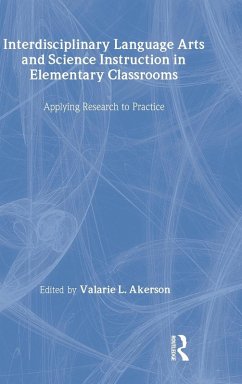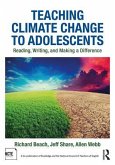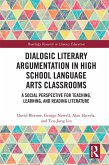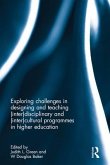Valarie L. Akerson (ed.)Applying Research to Practice
Interdisciplinary Language Arts and Science Instruction in Elementary Classrooms
Applying Research to Practice
Herausgeber: Akerson, Valarie L.
Valarie L. Akerson (ed.)Applying Research to Practice
Interdisciplinary Language Arts and Science Instruction in Elementary Classrooms
Applying Research to Practice
Herausgeber: Akerson, Valarie L.
- Gebundenes Buch
- Merkliste
- Auf die Merkliste
- Bewerten Bewerten
- Teilen
- Produkt teilen
- Produkterinnerung
- Produkterinnerung
This volume brings together evidence-based approaches to interdisciplinary language arts and science instruction. Firmly grounded in the research showing cognitive parallels between the two subjects, and reflecting the many recommendations in recent years for using interdisciplinary instruction at the elementary level, its goal is to help teachers
Andere Kunden interessierten sich auch für
![Interdisciplinary Perspectives on Learning to Read Interdisciplinary Perspectives on Learning to Read]() Interdisciplinary Perspectives on Learning to Read204,99 €
Interdisciplinary Perspectives on Learning to Read204,99 €![Teaching Climate Change to Adolescents Teaching Climate Change to Adolescents]() Richard BeachTeaching Climate Change to Adolescents148,99 €
Richard BeachTeaching Climate Change to Adolescents148,99 €![Dialogic Literary Argumentation in High School Language Arts Classrooms Dialogic Literary Argumentation in High School Language Arts Classrooms]() David BloomeDialogic Literary Argumentation in High School Language Arts Classrooms167,99 €
David BloomeDialogic Literary Argumentation in High School Language Arts Classrooms167,99 €![Interdisciplinary Education in the Age of Assessment Interdisciplinary Education in the Age of Assessment]() Interdisciplinary Education in the Age of Assessment212,99 €
Interdisciplinary Education in the Age of Assessment212,99 €![Principles and Practices of Working with Pupils with Special Educational Needs and Disability Principles and Practices of Working with Pupils with Special Educational Needs and Disability]() Trevor CotterillPrinciples and Practices of Working with Pupils with Special Educational Needs and Disability168,99 €
Trevor CotterillPrinciples and Practices of Working with Pupils with Special Educational Needs and Disability168,99 €![An Interdisciplinary Approach to Early Childhood Education and Care An Interdisciplinary Approach to Early Childhood Education and Care]() Susanne GarvisAn Interdisciplinary Approach to Early Childhood Education and Care195,99 €
Susanne GarvisAn Interdisciplinary Approach to Early Childhood Education and Care195,99 €![Interdisciplinary and Intercultural Programmes in Higher Education Interdisciplinary and Intercultural Programmes in Higher Education]() Interdisciplinary and Intercultural Programmes in Higher Education167,99 €
Interdisciplinary and Intercultural Programmes in Higher Education167,99 €-
-
-
This volume brings together evidence-based approaches to interdisciplinary language arts and science instruction. Firmly grounded in the research showing cognitive parallels between the two subjects, and reflecting the many recommendations in recent years for using interdisciplinary instruction at the elementary level, its goal is to help teachers
Produktdetails
- Produktdetails
- Verlag: Routledge
- Seitenzahl: 332
- Erscheinungstermin: 19. Juli 2007
- Englisch
- Abmessung: 235mm x 157mm x 22mm
- Gewicht: 633g
- ISBN-13: 9780805860023
- ISBN-10: 0805860029
- Artikelnr.: 22954158
- Herstellerkennzeichnung
- Libri GmbH
- Europaallee 1
- 36244 Bad Hersfeld
- gpsr@libri.de
- Verlag: Routledge
- Seitenzahl: 332
- Erscheinungstermin: 19. Juli 2007
- Englisch
- Abmessung: 235mm x 157mm x 22mm
- Gewicht: 633g
- ISBN-13: 9780805860023
- ISBN-10: 0805860029
- Artikelnr.: 22954158
- Herstellerkennzeichnung
- Libri GmbH
- Europaallee 1
- 36244 Bad Hersfeld
- gpsr@libri.de
Valarie L. Akerson
Contents: Preface. Part I:Introduction to Interdisciplinary Science and Language Arts Instruction.V.L. Akerson
T.A. Young
Why Interdisciplinary Language Arts and Science Instruction? J.C. Richards
Interdisciplinary Teaching: History
Theory
and Interpretations. T.D. Sadler
Sociocultural Perspective on Scientific Literacy and Learning Science. Part II:The Influence of Interdisciplinary Science and Language Arts Instruction on Children's Learning.J.A. Morrison
Teachers' Use of Science Notebooks to Assess Understanding of Science Concepts. D.T. Crowther
J.R. Cannon
Using the THC Model of Science Investigation and Science Notebooking in Elementary and Middle-Level Science Classrooms. D.A. Powell
R.J. Aram
Children Publish in Science as a Way of Knowing. D. Crowther
M. Robinson
A. Edmundson
A. Colburn
Preparing English Language Learners in the Science Classroom. C. Gile
Inquiry Curriculum in the Primary Grades. Part III:Research on Preparing Elementary Teachers to Use Interdisciplinary Science and Language Arts Instruction.W.P. Bintz
S. Moore
Using a Literature-Based Text Cluster to Teach Science. J.C. Richards
K.T. Shea
Interdisciplinary Teaching in the Primary Grades: Preservice Teachers' Dilemmas and Achievements Connecting Science
the Arts
and Reading. J.A. Morrison
Using Science Notebook Writing to Promote Preservice Teachers' Understanding of Formative Assessment. I. Graves
T. Phillipson
Using Critical Literacy in the Science Classroom. S.J. Britsch
D.P. Shepardson
CLASP: An Approach to Helping Teachers Interpret Children's Science Journaling. L.Y. Lu
Semiotics for Integrating Geosciences Into Literacy in Teacher Education. V.L. Akerson
Using Action Research Projects to Help Preservice Elementary Teachers Effectively Use Interdisciplinary Language Arts and Science Instruction.Part IV:Conclusions and Recommendations. V.L. Akerson
T.A. Young
What Do We Know From Our Research? What Do We Still Need to Know? Conclusions and Recommendations.
T.A. Young
Why Interdisciplinary Language Arts and Science Instruction? J.C. Richards
Interdisciplinary Teaching: History
Theory
and Interpretations. T.D. Sadler
Sociocultural Perspective on Scientific Literacy and Learning Science. Part II:The Influence of Interdisciplinary Science and Language Arts Instruction on Children's Learning.J.A. Morrison
Teachers' Use of Science Notebooks to Assess Understanding of Science Concepts. D.T. Crowther
J.R. Cannon
Using the THC Model of Science Investigation and Science Notebooking in Elementary and Middle-Level Science Classrooms. D.A. Powell
R.J. Aram
Children Publish in Science as a Way of Knowing. D. Crowther
M. Robinson
A. Edmundson
A. Colburn
Preparing English Language Learners in the Science Classroom. C. Gile
Inquiry Curriculum in the Primary Grades. Part III:Research on Preparing Elementary Teachers to Use Interdisciplinary Science and Language Arts Instruction.W.P. Bintz
S. Moore
Using a Literature-Based Text Cluster to Teach Science. J.C. Richards
K.T. Shea
Interdisciplinary Teaching in the Primary Grades: Preservice Teachers' Dilemmas and Achievements Connecting Science
the Arts
and Reading. J.A. Morrison
Using Science Notebook Writing to Promote Preservice Teachers' Understanding of Formative Assessment. I. Graves
T. Phillipson
Using Critical Literacy in the Science Classroom. S.J. Britsch
D.P. Shepardson
CLASP: An Approach to Helping Teachers Interpret Children's Science Journaling. L.Y. Lu
Semiotics for Integrating Geosciences Into Literacy in Teacher Education. V.L. Akerson
Using Action Research Projects to Help Preservice Elementary Teachers Effectively Use Interdisciplinary Language Arts and Science Instruction.Part IV:Conclusions and Recommendations. V.L. Akerson
T.A. Young
What Do We Know From Our Research? What Do We Still Need to Know? Conclusions and Recommendations.
Contents: Preface. Part I:Introduction to Interdisciplinary Science and Language Arts Instruction.V.L. Akerson
T.A. Young
Why Interdisciplinary Language Arts and Science Instruction? J.C. Richards
Interdisciplinary Teaching: History
Theory
and Interpretations. T.D. Sadler
Sociocultural Perspective on Scientific Literacy and Learning Science. Part II:The Influence of Interdisciplinary Science and Language Arts Instruction on Children's Learning.J.A. Morrison
Teachers' Use of Science Notebooks to Assess Understanding of Science Concepts. D.T. Crowther
J.R. Cannon
Using the THC Model of Science Investigation and Science Notebooking in Elementary and Middle-Level Science Classrooms. D.A. Powell
R.J. Aram
Children Publish in Science as a Way of Knowing. D. Crowther
M. Robinson
A. Edmundson
A. Colburn
Preparing English Language Learners in the Science Classroom. C. Gile
Inquiry Curriculum in the Primary Grades. Part III:Research on Preparing Elementary Teachers to Use Interdisciplinary Science and Language Arts Instruction.W.P. Bintz
S. Moore
Using a Literature-Based Text Cluster to Teach Science. J.C. Richards
K.T. Shea
Interdisciplinary Teaching in the Primary Grades: Preservice Teachers' Dilemmas and Achievements Connecting Science
the Arts
and Reading. J.A. Morrison
Using Science Notebook Writing to Promote Preservice Teachers' Understanding of Formative Assessment. I. Graves
T. Phillipson
Using Critical Literacy in the Science Classroom. S.J. Britsch
D.P. Shepardson
CLASP: An Approach to Helping Teachers Interpret Children's Science Journaling. L.Y. Lu
Semiotics for Integrating Geosciences Into Literacy in Teacher Education. V.L. Akerson
Using Action Research Projects to Help Preservice Elementary Teachers Effectively Use Interdisciplinary Language Arts and Science Instruction.Part IV:Conclusions and Recommendations. V.L. Akerson
T.A. Young
What Do We Know From Our Research? What Do We Still Need to Know? Conclusions and Recommendations.
T.A. Young
Why Interdisciplinary Language Arts and Science Instruction? J.C. Richards
Interdisciplinary Teaching: History
Theory
and Interpretations. T.D. Sadler
Sociocultural Perspective on Scientific Literacy and Learning Science. Part II:The Influence of Interdisciplinary Science and Language Arts Instruction on Children's Learning.J.A. Morrison
Teachers' Use of Science Notebooks to Assess Understanding of Science Concepts. D.T. Crowther
J.R. Cannon
Using the THC Model of Science Investigation and Science Notebooking in Elementary and Middle-Level Science Classrooms. D.A. Powell
R.J. Aram
Children Publish in Science as a Way of Knowing. D. Crowther
M. Robinson
A. Edmundson
A. Colburn
Preparing English Language Learners in the Science Classroom. C. Gile
Inquiry Curriculum in the Primary Grades. Part III:Research on Preparing Elementary Teachers to Use Interdisciplinary Science and Language Arts Instruction.W.P. Bintz
S. Moore
Using a Literature-Based Text Cluster to Teach Science. J.C. Richards
K.T. Shea
Interdisciplinary Teaching in the Primary Grades: Preservice Teachers' Dilemmas and Achievements Connecting Science
the Arts
and Reading. J.A. Morrison
Using Science Notebook Writing to Promote Preservice Teachers' Understanding of Formative Assessment. I. Graves
T. Phillipson
Using Critical Literacy in the Science Classroom. S.J. Britsch
D.P. Shepardson
CLASP: An Approach to Helping Teachers Interpret Children's Science Journaling. L.Y. Lu
Semiotics for Integrating Geosciences Into Literacy in Teacher Education. V.L. Akerson
Using Action Research Projects to Help Preservice Elementary Teachers Effectively Use Interdisciplinary Language Arts and Science Instruction.Part IV:Conclusions and Recommendations. V.L. Akerson
T.A. Young
What Do We Know From Our Research? What Do We Still Need to Know? Conclusions and Recommendations.









